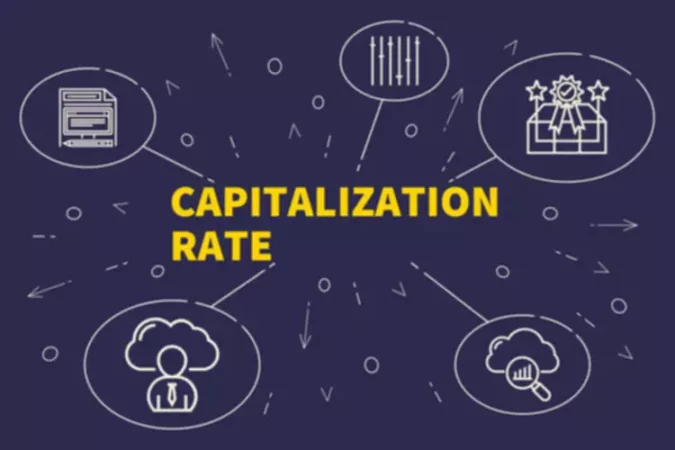Individuals who are relatively new to the world of real estate finance often do not really understand the concepts capitalization rates and how one applies them in commercial real estate. That is not a problem because this article will introduce you to all the basics you should know about this concept in simple to understand way and using examples. We will also explain why it is valuable for investors and why it might not be telling the whole truth.
Definition
The capitalization rate is really a “gold standard” for real estate metrics. Also known as cap rate, officially, the capitalization rate is defined as a yearly return as a percentage that you receive in rent for the property. It is a mathematical measurement of how much income an asset produces relative to the purchase price. If explained simply, it is like a checking account rate that you see in the account or any other investment type that you have.
Calculation
To calculate the capitalization rate value, you would need two pieces of information: income and current market value. We would like to bring it to your attention that you would not use the property price, but use a current market value in your calculation. The income part is actually a very special type of income called net operating income. This would be your gross income from rent, storage, parking, laundry, vending, and other income that the property collects subtracted by any vacancies and operating costs.
Operating costs are things like utilities, office supplies, maintenance, repairs, property management, advertising, and anything that occurs on a regular basis. It does not include capital expenditures, such as replacing a roof because it will last you 30 years, and financial expenses, such as mortgage or loan payments. So, net operating income is calculated before interest, depreciation, amortization, and taxes because these factors vary greatly from property to property and make the comparison hard. It is also important to note that you need to use an actual net operating income and not pro forma, which is really just a guess, when doing the calculation.
You would use the following formula to do your calculations:

Meaning for Investors
Have you ever noticed how properties in different parts of the country, single-family homes, for example, vary dramatically in price for the same type of structure? For example, a single-family home in San Francisco might be close to a million dollars, while the same structure might be $100,000 or $150,000 out in the Midwest. That is because people are willing to pay a premium for the same types of property in different parts of the country. They are expecting those other areas of the country, perhaps San Francisco, to appreciate in value. That same line of thinking can be applied to capital rates.
Let’s say that we had a property in San Francisco that was priced at $2.5 million and produced a $100K income. That income is 4% of the purchase price. That means that capitalization on that property is 4%. The same structure out in the Midwest might have a cap rate of 10%. This brings us to the question as investors “Why would anyone want to purchase a property with a lower cap rate, a property that produces less income per dollar invested?” and “Why would I want to make a $2.5 million investment for $100K in income when I could pay $1 million for $400K in income?”. Well, there are a couple of reasons for this.
- Potential. Investors or at least the market values the property in certain locations higher than others because of possible income production in the future. Perhaps in San Francisco, the rents that the buildings are going to produce are going to rise faster than they are in a property in the Midwest.
- Leverage. This concept is a little bit more abstract. If the property management is able to cut expenses of a property that produces $100K by $10,000 a year. Now, the income the asset produces is $110K per year. At a 4% cap rate, the management has produced $250,000 in value, so the property goes from $2.5 million to $2.75 million, which is large value creation. Cutting that same expense in a 10% cap rate property, you would increase the value of the property by only $100,000.
Thus, somewhat more opportunity is present if you can cut costs and capture a lot of value more quickly in mortgage with lower capitalization rates. Despite this, we want to factor in cash flow and the fact that your investment would have higher cash return in a higher cap rate market is generally a good thing for a lot of cash flow investors. Higher cap investment in real estate usually indicates that it is a higher risk property and a low-risk asset will be in a good area and good condition, but with lower cap.
Uses of Cap Rate
The capitalization rate can be used in several cases:
- Compare properties
If you have Property X and Property Y and need to decide which one to choose, this financial metric can help you out. Let’s say Property X’s current market value is $499,000 and NOI is $40,500. The cap rate for Property X would be 8.1%. Property Y’s value is $399,000 and NOI is $35,800. The cap rate for Property Y would be 8.97%. Based on just the capitalization rate, Property Y can be your property of choice. However, there might be other factors that can influence your decision. For instance, you might be getting a really good mortgage for Property X.
- Goal-based investing
The cap rate can be utilized in goal-based investing where you basically calculate the value by dividing the NOI by the cap rate. Suppose that you know that net operating income is $85,000 and the capitalization rate is 7%. This allows you to calculate the value. In our case, it will be $1,214,285 and this is the maximum value you would want to give for this property.
- Analyze trends
This financial metric can also help one to analyze trends. For instance, the historical cap rate at a specific location is 9% and the current rate is 6%. Due to the fact that the capitalization rate went down, the market value related to the asset’s NOI is going up, which indicates speculation. This means that now it would make sense to sell the property because you are getting a good market value compared to net operating income. If the historical rate was lower, though, it would mean the market value related to the property’s NOI is going down. This would indicate an opportunity to buy.

















